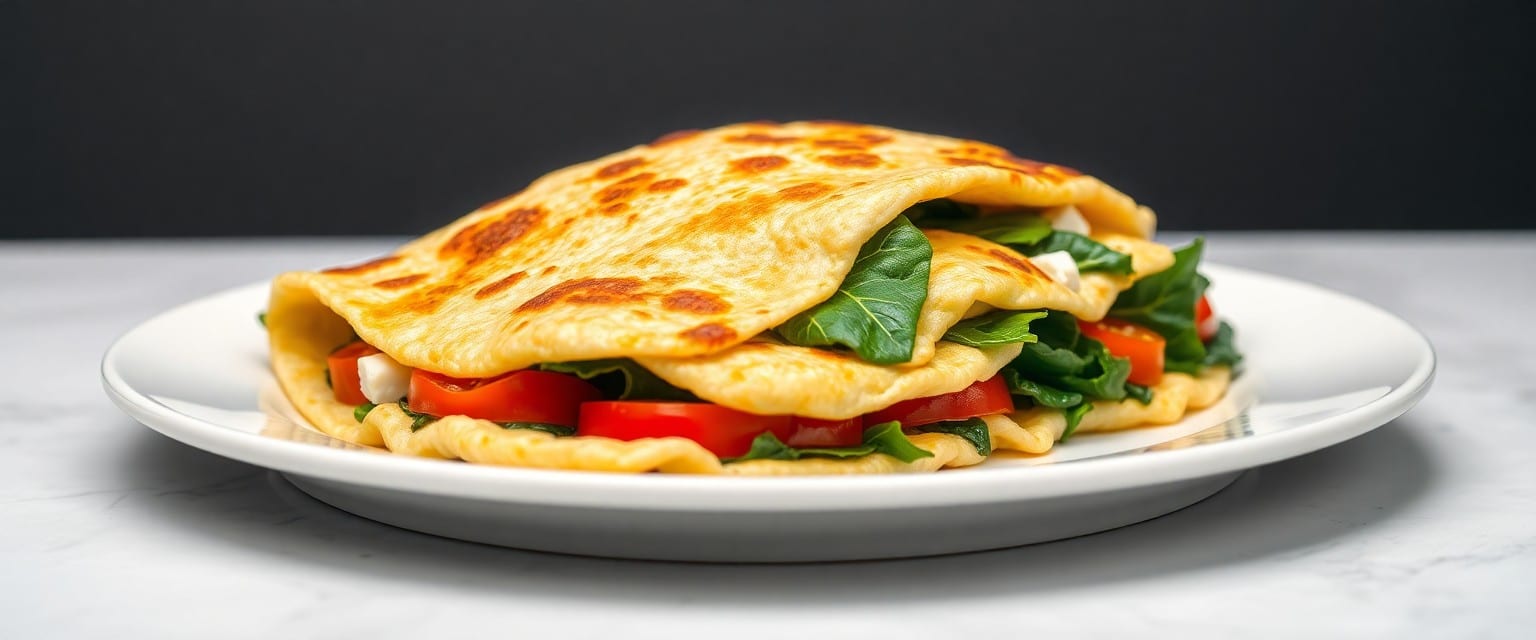Energizing Your Morning: The Power of Protein
Eggs deliver a complete profile of crucial amino acids, fueling muscle repair and keeping your hunger at bay longer than carbs alone. Combining them with fiber-rich vegetables like spinach and bell peppers not only enhances vitamin intake but also supports digestion and steady blood sugar levels. Starting your day with around 20 grams of protein—easily hit with a two-egg omelette or a couple of egg muffins—gives your metabolism a jumpstart and sustains energy for busy mornings or workout sessions ahead.
Powering Your Morning: The Importance of High-Protein Breakfasts
Starting your day with a high-protein breakfast, like eggs, delivers all nine important amino acids needed for muscle repair and sustained energy. Combining eggs with vegetables adds a boost of fiber and micronutrients—helping you feel fuller longer and supporting digestion. Studies show that consuming at least 20–30 grams of protein at breakfast can enhance concentration and curb mid-morning cravings, making these veggie-packed omelettes and egg muffins an ideal choice whether you’re rushing out or planning ahead.
Crafting the Perfect Veggie Omelette
Mastering the veggie omelette starts with balancing fresh ingredients and gentle cooking techniques. Selecting a rainbow of vegetables like spinach, cherry tomatoes, and bell peppers infuses vibrant color and nutrients, while whisking eggs with a splash of milk ensures fluffy texture. Achieving the right heat and timing prevents tough, rubbery eggs, letting you fold in light cheese like feta toward the end for a creamy finish. This straightforward approach delivers a satisfying, protein-rich breakfast in about 10 minutes, perfect for fueling your busy mornings.
Whisk and Prepare: Essential Ingredients and Techniques
Whisk 2–3 eggs with a splash of milk to introduce air for that soft, fluffy texture. Light seasoning with salt and pepper enhances the natural flavors, while chopping colorful vegetables—spinach, halved cherry tomatoes, diced bell peppers—adds fiber and micronutrients. Keep the ingredients ready before heating your non-stick pan to medium, ensuring seamless cooking. Folding in cottage or feta cheese near the end adds creaminess without overpowering the vegetables, rounding out this high-protein, nutrient-packed meal.
Cooking Instructions for Fluffy Perfection
Pour the egg mixture into a preheated, medium-heat non-stick pan, letting it cook gently without stirring. Once the edges begin to set but the center remains slightly runny, scatter your prepared veggies evenly across the surface. Add cheese in the last minute, then carefully fold the omelette in half. Cook a few more seconds to allow melting without browning. This gentle heat control and timing creates a tender, fluffy omelette free of overcooked dryness.
Using medium heat prevents the eggs from browning too fast, giving the proteins time to set while retaining moisture. Avoid stirring after pouring, which can cause a scrambled texture instead of the classic omelette form. Vegetables added too early may release excess water, so scatter them when eggs are partially set to keep your omelette from becoming soggy. Adding cheese toward the end ensures it melts smoothly without hardening. A well-timed fold seals in fillings, making every bite flavorful and light within a quick 10-minute prep and cook window.
Flavor and Texture Enhancements: Tips for Beginners
Incorporate fresh herbs like parsley or chives for an aromatic lift, and toss in a pinch of smoked paprika or chili flakes to elevate depth. Using a splash of milk or water when whisking eggs boosts fluffiness, while lightly sautéing firmer veggies beforehand softens their bite. Choose light cheeses like feta or cottage for creaminess without heaviness. Any adjustments here can transform your omelette from simple to sensational.

- Protein-rich eggs provide important amino acids
- Fresh colorful veggies boost fiber and micronutrients
- Medium heat cooking prevents dryness and overbrowning
- Cheese added late ensures creaminess without toughness
- Any combination of herbs and spices personalizes flavor
- Whisk eggs with milk for fluffiness
- Light sauté of veggies enhances texture
- Use non-stick pan for easy cooking and folding
- Choose light cheeses for balanced creaminess
- Any small change can help refine your omelette technique
Crafting the Perfect Veggie Omelette
Whipping up a fluffy veggie omelette is all about balancing texture and flavor. Fresh, colorful vegetables combined with tender eggs and a touch of light cheese create a satisfying, protein-packed meal. With about 10 minutes from start to finish, this quick recipe fits seamlessly into busy mornings, offering a nutrient-rich plate that fuels your day. Mastering a few simple techniques—like using medium heat and stirring gently—ensures every bite melts in your mouth while keeping that vibrant veggie crunch intact.
Mastering the Egg Mixture: Whisking for Fluffiness
Whisk your eggs vigorously with a splash of milk to incorporate air, transforming the mixture into a light, airy base for your omelette. This step increases fluffiness by trapping air bubbles that expand during cooking. Seasoning early with salt and pepper allows flavors to infuse evenly throughout. Avoid over-whisking, which can break down the proteins, and aim for a smooth, pale yellow consistency before pouring into the pan.
Choosing Your Veggies: Selecting Fresh and Flavorful Ingredients
Opt for bright, fresh vegetables like tender spinach, juicy cherry tomatoes, and crisp bell peppers to pack your omelette with vibrant color and nutrients. These choices provide a perfect mix of fiber, vitamins, and subtle sweetness that complements the eggs. Using seasonal produce not only enhances flavor but also boosts micronutrient content, turning your omelette into a powerhouse of taste and health.
Delve deeper into your veggie selection by considering texture contrasts—crispy peppers add a satisfying snap, while spinach offers a soft, silky bite. Cherry tomatoes burst with juiciness and a touch of natural acidity, balancing the richness of eggs and cheese. If you want extra depth, lightly sautéing firmer veggies like bell peppers before adding them can release natural sugars, elevating your omelette’s flavor profile without added fat.
Cooking Techniques: Achieving the Ideal Texture and Taste
Cooking your omelette over medium heat helps ensure it sets gently without browning too fast or drying out. Pour the whisked eggs into a non-stick pan, letting edges firm while gently lifting and tilting the pan to spread uncooked egg evenly. Add cheese towards the end to melt just right, creating a luscious, creamy finish. Avoid high heat, which toughens eggs and diminishes that tender, fluffy texture you want.
For best results, maintain patience as the eggs cook slowly—this lets proteins solidify without shrinking tightly or turning rubbery. Sliding a spatula underneath as it cooks helps release steam, preventing sogginess and promoting even cooking. If folding the omelette, do so gently to preserve airiness while enveloping your fresh veggies and cheese inside a warm, melt-in-your-mouth blanket of flavor and texture.
Savory Egg Muffins: Your Make-Ahead Breakfast Solution
Egg muffins bring convenience without sacrificing nutrition—packed with veggies and protein, they’re easy to prepare in advance and perfect for busy mornings. Whisking eggs with a splash of Greek yogurt or milk keeps them moist and tender, while vibrant additions like broccoli, peppers, and feta boost flavor and nutrients. Once baked, these muffins store well in the fridge or freezer, giving you portable, ready-to-go breakfasts that sustain energy and satisfy hunger on hectic days.
Ingredients and Preparation: Creating a Flavorful Base
Start by whisking together eggs, a little Greek yogurt or milk, salt, and pepper to form a smooth, rich base. Stir in finely chopped vegetables such as broccoli, diced bell peppers, and onions for a colorful nutrient boost. Crumbled feta cheese adds a light, tangy richness, balancing the savory veggies. Make sure your veggies are chopped evenly to ensure consistent cooking and bite-sized muffins packed with flavor.
Baking to Perfection: Timings and Temperature Control
Bake the egg muffins in a preheated oven at 180 °C (350 °F) for approximately 18–20 minutes, until they’re fully set but still moist inside. Using a greased muffin tin prevents sticking and helps with easy removal. Keep an eye on them after 15 minutes to avoid dryness, and test doneness with a toothpick—if it comes out clean, they’re ready to enjoy. Slight variations in oven heat may affect timing, so adjust accordingly.
Baking Tips and Timing Details
| Aspect | Details & Tips |
|---|---|
| Oven Temperature | 180 °C (350 °F) ensures even cooking without overbrowning. |
| Baking Time | 18–20 minutes, monitor closely after 15 minutes for texture checks. |
| Testing Doneness | Toothpick test: clean exit means muffins are fully set. |
| Muffin Tin Preparation | Greasing or silicone liners prevent sticking and ease removal. |
| Moisture Control | Adding Greek yogurt keeps muffins tender; avoid overbaking to retain moisture. |
Customization Options: Mix and Match for Variety
Feel free to swap or add ingredients like fresh spinach, grated zucchini, or diced lean ham to tailor your muffins to your taste and seasonal produce. They’re kid-friendly and portable, making them great for lunchboxes or quick snacks. Experimenting with different cheeses, herbs, or spices can add exciting twists without complicating meal prep—offering you endless nutritious, protein-rich options to keep breakfast fresh and fun.
By rotating veggies like kale or mushrooms and incorporating herbs such as parsley or chives, you boost both flavor and micronutrients. Adding lean proteins like turkey or chicken sausage can up the protein content further, ideal for muscle recovery or longer-lasting energy. These muffins adapt easily to your pantry and preferences, helping you maintain a healthy, convenient breakfast routine.
Egg Muffins: The Ultimate Make-Ahead Breakfast
Batch-prepping egg muffins means you can enjoy a nutritious, high-protein breakfast anytime without morning fuss. Simply whisk eggs with your choice of dairy, mix in vibrant veggies and cheese, then bake until perfectly set. These muffins stay fresh in the fridge for up to five days or freeze effortlessly, making them an ideal grab-and-go solution. Whether packed for work, school, or weekend hikes, they deliver sustained energy through a balanced blend of protein and fiber-rich vegetables.
The Egg Base: Incorporating Yogurt for Creaminess
Adding a spoonful of Greek yogurt to your whisked eggs creates a luxuriously creamy texture in your egg muffins without extra fat. Yogurt boosts the protein content and keeps muffins moist, improving the overall mouthfeel. It also adds a subtle tang that complements the savory vegetables and cheese, transforming the humble egg mixture into a richer, more satisfying breakfast treat that’s as delicious as it is nourishing.
Vegetable Fusion: Creative Combinations for Maximum Nutrition
Chop up colorful, nutrient-dense veggies like broccoli, bell peppers, and onions to infuse your egg muffins with flavor and fiber. Feel free to experiment: zucchini, spinach, or even shredded carrots add variety and boost antioxidant content. Mixing in feta or cottage cheese complements the fresh produce and rounds out the taste profile, turning each muffin into a compact powerhouse of vitamins and minerals perfect for a health-conscious start.

Baking Tips: Ensuring Perfectly Set Muffins Every Time
Monitoring oven temperature and baking duration ensures your egg muffins come out fluffy but fully cooked. Baking at 180 °C (350 °F) for 18–20 minutes cooks the eggs evenly without drying them out. Using a greased muffin tin or silicone liners prevents sticking and makes removal simple. Avoid opening the oven door too often, so the temperature remains stable and muffins rise properly. Perceiving doneness is easier when the tops feel firm and a toothpick inserted comes out clean.
To achieve consistent, perfectly set egg muffins, start by preheating the oven fully to the recommended 180 °C (350 °F). Greasing your muffin tin well or using non-stick liners prevents the muffins from sticking, preserving their shape. Avoid overcrowding the pan to allow heat circulation. Keep an eye on the last few minutes of baking—ovens vary, so adjust time slightly if needed. Insert a toothpick or fork in the center; if it comes out clean with no wet egg, your muffins are set. Perceiving the subtle golden color on top also signals readiness, ensuring firm yet moist results every batch.
- High-protein content from eggs and dairy
- Vegetable fusion for nutrient diversity
- Baking tips to avoid dryness or undercooking
- Batch prep friendly and freezer adaptable
- Perceiving visual and tactile cues to confirm doneness
Meal Prep Mastery: Building a Breakfast Routine
Incorporating these high-protein egg dishes into your weekly routine sets you up for mornings without hassle. By prepping omelettes or egg muffins in advance, you can enjoy nutrient-packed breakfasts that deliver lasting energy and keep hunger at bay. A little planning—like prepping veggies ahead or mixing batter the night before—transforms busy mornings into smooth starts, letting you focus on the day ahead while fueling your body efficiently.
Efficient Batch Preparation Techniques
Whisk together larger egg mixtures and bulk-chop your colorful veggies to save time. Pour the egg muffin batter into muffin tins all at once for uniform cooking, then cool and portion immediately. For omelettes, prepare fillings in advance and refrigerate separately; this way, you simply cook the eggs fresh while adding pre-chopped vegetables and cheese. Investing 30–40 minutes on a Sunday can easily cover breakfasts for the entire week, streamlining your mornings without sacrificing freshness.
Storage Solutions: Keep It Fresh for On-the-Go
Store baked egg muffins in airtight containers in the fridge for up to 4 days, or freeze them in portions wrapped tightly with plastic wrap or placed in freezer bags. Omelette leftovers keep best when separated from fillings in sealed containers to maintain texture. Using silicone muffin liners and clear storage boxes helps preserve shape and makes grabbing your breakfast quick and mess-free, ideal for busy mornings on the move.
Freezing egg muffins individually ensures they defrost evenly and quickly—just pop one in the fridge overnight or reheat in the microwave for about 60 seconds. Label containers with preparation dates to track freshness, and consider portion sizes that fit your appetite to avoid waste. For omelettes, refrigerate fillings separately and reheat gently in a low-temperature pan or microwave to maintain a fluffy texture. Investing in quality airtight containers with secure lids and BPA-free materials can significantly extend shelf life and preserve flavors, giving you confidence that your grab-and-go breakfasts stay delicious and ready whenever you are.
Flavor Customization: Personalize Your Meals
You can easily tailor these high-protein breakfast options to suit your taste buds or what’s on hand. Swapping in different veggies like roasted mushrooms or sun-dried tomatoes adds exciting new layers, while experimenting with cheeses—from tangy feta to mild mozzarella—changes the flavor profile without extra effort. Herbs like basil, chives, or parsley bring fresh brightness, and a pinch of smoked paprika or chili flakes kicks up the heat if you want a little zing. These small tweaks keep your meals interesting and ensure you never get bored of your morning routine.
Seasonal Ingredient Swaps: Keeping It Fresh and Exciting
Using seasonal produce maximizes flavor and nutrition in your omelettes and egg muffins. Spring invites crisp asparagus or tender peas; summer bursts with juicy tomatoes and zucchini; autumn welcomes roasted squash and kale; winter shines with hearty leeks and sweet root vegetables. Rotating your ingredients this way not only keeps recipes fresh but also supports local farmers and reduces environmental impact, making your breakfasts as sustainable as they are delicious.
Kid-Friendly Variations: Making Breakfast Fun for Everyone
Never underestimate the power of colorful, bite-sized veggies like diced carrots, sweet corn, or little broccoli florets in winning over picky eaters. Mild cheeses such as mozzarella or cheddar often appeal more than stronger options. You can cleverly involve kids by letting them choose or add toppings themselves, turning breakfast prep into a fun, interactive experience. Mini egg muffins especially work well as handheld snacks that are less messy and perfectly portioned for little hands.
Adding finely diced or grated veggies into egg muffins boosts fiber and vitamins without overwhelming children’s palates, especially paired with familiar cheeses like cheddar or mild gouda. Keeping seasonings gentle and textures soft improves acceptance among younger eaters; for example, swapping raw onions for caramelized ones adds sweetness. Many parents find that making batches ahead offers convenience for busy mornings and encourages kids to explore new flavors in a convenient format. These adjustments turn wholesome breakfasts into approachable, enjoyable meals for the whole family.
The Nutritional Edge: Why Veggies and Eggs Matter
Combining eggs with vibrant vegetables creates a breakfast powerhouse that fuels your body efficiently. Eggs contribute complete proteins packed with all nine important amino acids, supporting muscle health and satiety. Meanwhile, fresh veggies like spinach, bell peppers, and cherry tomatoes deliver fiber and a rich spectrum of micronutrients—vitamins, minerals, and antioxidants—that enhance digestion and immune function. This blend suits meal-prep enthusiasts and busy mornings alike, ensuring you get a well-rounded, nutrient-dense start that keeps energy steady and cravings at bay.
The Role of Protein in Your Diet
Protein forms the building blocks for muscle repair, hormone production, and enzyme function. By including egg-based dishes in your breakfast, you provide your body with high-quality protein that helps stabilize blood sugar and prolongs fullness. Aiming for about 20–30 grams of protein each morning supports metabolism and cognitive focus, setting a solid nutritional foundation for your day whether you’re rushing to work or working out.
Micronutrients and Health Benefits of Vegetables
Vegetables add more than just color to your meal—they offer an array of micronutrients like vitamin C, potassium, and folate that play roles in heart health, blood pressure regulation, and cellular repair. Including a variety of veggies boosts fiber intake, which aids digestion and maintains blood sugar balance. Fresh choices like spinach provide iron and magnesium, cherry tomatoes supply lycopene for antioxidant support, and peppers pack vitamin A for healthy skin and vision.
Diving deeper, many vegetables bring unique phytonutrients and antioxidants to your breakfast plate, which can reduce inflammation and promote overall wellness. For example, broccoli in egg muffins offers sulforaphane, known for its potential anti-cancer properties, while bell peppers deliver carotenoids that improve immune defenses. This combination not only enriches your meal’s flavor and texture but builds a nutritional profile that supports long-term health, making these recipes as smart as they are satisfying.
High‑Protein Veggie Omelette
Servings: 1 | Prep Time: 5 mins | Cook Time: 5 mins
Ingredients:
- 2 large eggs
- ¼ cup cottage cheese or feta
- Handful of baby spinach
- ¼ cup cherry tomatoes, halved
- ¼ red bell pepper, diced
- Salt & pepper to taste
- 1 tsp olive oil or butter
Instructions:
- Whisk eggs with salt and pepper in a bowl.
- Heat oil in a non-stick pan over medium heat.
- Add bell pepper and tomatoes, sauté for 2 minutes.
- Pour in eggs, swirl to coat the pan.
- Top with spinach and cheese, cook until nearly set.
- Fold gently and cook another minute until done.
Tip: Use a silicone spatula and medium heat for perfect results!
High-Protein Benefits: Why These Dishes Fuel Your Day
Both the veggie omelette and egg muffins deliver a powerful protein punch, helping you stay fuller longer and support muscle repair after sleep. Eggs provide all nine important amino acids, making them a top-notch source of complete protein. Paired with fiber-rich vegetables like spinach, peppers, and broccoli, these dishes not only fuel your body but also aid digestion and boost micronutrient intake. Whether you’re prepping ahead or whipping up a quick meal, these options set you up with sustained energy and nutrient density to power through your morning.
Nutrition Breakdown: Eggs and Vegetables as Powerhouses
Eggs deliver about 6 grams of high-quality protein per large egg, containing all important amino acids needed for muscle maintenance and hormone production. Vegetables contribute valuable fiber, vitamins A, C, K, and minerals like potassium and magnesium, which support overall health and metabolic function. Combining these ingredients in your breakfast increases nutrient synergy—fiber slows digestion for steady energy release, while eggs promote satiety and metabolism. Adding light cheese such as feta or cottage cheese boosts calcium and protein content without overwhelming calories, creating a balanced and nourishing meal.
Sustained Energy: The Role of Protein in Your Breakfast Routine
Protein slows the absorption of carbohydrates, leading to a gradual rise in blood sugar and helping prevent mid-morning slumps. Eggs’ amino acids stimulate muscle protein synthesis, aiding recovery and keeping your energy stable. Meanwhile, fiber-rich veggies provide bulk and micronutrients that support steady digestion and cognitive function. Eating protein-packed breakfasts like these veggie omelettes or egg muffins ensures you have long-lasting fuel, unlike sugary or carb-heavy options that spike and crash your energy.
Extending beyond satiety, protein interacts with hormones like glucagon to maintain blood glucose balance, minimizing insulin spikes that can lead to fatigue. Research shows that higher-protein breakfasts reduce cravings later in the day, helping you avoid energy dips and unnecessary snacking. Incorporating vegetables adds antioxidants and vitamins that support brain function and immune health, making these meals ideal for busy mornings when you need both physical and mental stamina. By choosing these high-protein, veggie-packed breakfasts, you’re setting deliberate momentum for the hours ahead.
Summing up
Taking this into account, you can easily boost your mornings with these high-protein veggie omelettes or egg muffins, both designed to keep you energized and satisfied. By incorporating fresh vegetables and quality protein sources like eggs and cheese, you support a balanced, nutrient-rich start that suits busy schedules and meal-prep routines. Feel free to customize the recipes with your favorite seasonal produce to keep variety and enjoyment in your breakfasts. These dishes not only save time but also empower you to maintain consistent, wholesome eating habits throughout your day.
Frequently Asked Questions
What makes these recipes high-protein?
Eggs provide 6–7 g of complete protein each. Adding cottage cheese, Greek yogurt, or feta boosts protein even further per serving.
Can I meal prep the egg muffins?
Yes! Bake in bulk, refrigerate up to 5 days, or freeze for up to 2 months. Reheat in the microwave or oven for a quick snack or breakfast.
Are these recipes suitable for vegetarians?
Absolutely—packed with eggs and cheese, they’re suitable for lacto-ovo vegetarians and can be made gluten-free if no breadcrumbs are used.
How can I prevent the omelette from sticking?
Use a non-stick pan, medium heat, and a small knob of butter or oil. Let the eggs set slightly before lifting edges to fold.
Can I add other vegetables or proteins?
Yes—spinach, mushrooms, zucchini, or cooked chicken/ham work well. Adjust quantities to keep balance in the egg base.

